Through a two part blog post “series”, I will share how I make sourdough. Please read through it all and if you have questions, ask in comments and then I will respond in comments, as well as clarify the blog post. I have a tendency to know what I’m thinking (sometimes) but not write it clearly.
Now, with yeast in short supply, sourdough is the perfect bread to be baking.
First, there are many ways to make sourdough so you may have your way that works for you. I’m not going to try to go through all the ways I’ve read about or all the ways I’ve tried. This is how I’m currently making it and so far, it’s been no fail.
Second, I am going to reference Sourdough by Foodbod a LOT because her way is about the easiest way I’ve done so far. I rarely deviate from her methods/recipes. Elaine (the Sourdough by Foodbod lady) has a book coming out in the Fall. Is it Fall yet? 🙂
Her book is Wholegrain Sourdough at Home. You may not be interested in whole grains but if you are, I think it is going to be a fantastic book. She is very good with her instructions and her recipes are proven to be successful.
Third, and probably most important: It will take me longer to write all this than it does to actually stir up the bread so please do not let the length of the blog posts deter you from trying to make sourdough.
Please read the Sourdough by Foodbod website. It is so informative and seems so easy to follow but these posts are simply my take on the entire process. The website is very well organized. Elaine is the expert!
What You Need Before Starting:
Elaine has an entire section on Equipment & Ingredients. Specifically read her post about flour. I laughed when I read this part about flour: “In bygone times there would have been much less choice”. Obviously things are a bit different now with the pandemic but hopefully soon we’ll have flour on the supermaket shelves and available by mail order. Everything I write as far as ingredients is going to assume we’re not living under pandemic conditions so, at the current time, some things may be hard to find.
Here’s what you need and what you can use if you don’t have it:
Scale: You absolutely need a scale with tare and grams. I will hardly use a bread recipe that doesn’t list the ingredients by weight. They’re inexpensive or as expensive, if you want. This is the scale I’ve used for over 4 years and it’s currently about $14. Vince needed a scale outside so he took that one and I ordered this one for the kitchen. It’s about $31 now. I chose it because it has great ratings and I wanted one I wasn’t having to peek under a plate or bowl to see the readout. So far, I’m happy with it.
Lame: This is the blade on a stick for cutting/scoring the dough so it doesn’t erupt and make a nasty looking tear. This is the one I bought. Vince says a box cutter will do. I haven’t tried a box cutter but I paid $14 for the lame about two months ago (and had to wait a long time for it to get here) and now it’s $21. I used a long, sharp kitchen knife that was as thin as I could find in the drawer. It just doesn’t work as good as the razor blade on a stick but . . use your own judgment and be careful – it’s sharp!
Baking Dish with a Lid: I use this one from Walmart. (Free shipping with $35 so add something to the cart – this gets you very close to free shipping).
Parchment Paper: This isn’t 100% necessary but I like to fold it to fit my baking dish, the put the dough into the parchment paper for less to clean. I actually leave the parchment paper in the dish and use it a couple of times.
Shower Cap or Plastic Wrap: I buy disposable shower caps (about $13 for 100). You can use plastic wrap but there are multiple times you’re taking the cover off the dough and replacing it.
Banneton: I use this one. It’s a 9″ banneton. If you don’t have one and don’t want to invest in one, you can line a colander or 9″ bowl with parchment paper and use that.
Rice Flour: The rice flour does not stick where all purpose type flour is going to stick. If you have a wheat grinder, simply toss raw rice into it and it makes a nice rice flour. If you have a good blender, you might can grind rice into flour but you’ll probably want to sift it to get out any larger pieces. You’ll be surprised at how much rice flour you use so if you’re grinding your own, you may want to grind at least a cup at a time.
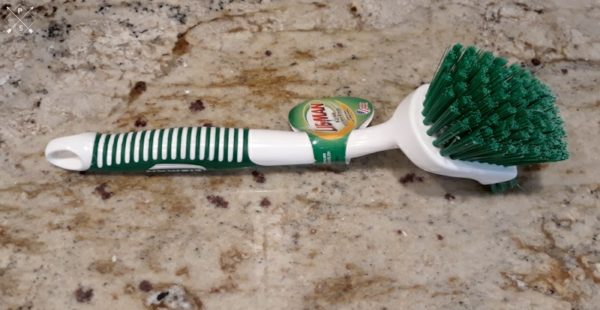
Stiff Brush: You need some way to clean your banneton. I let the banneton dry completely from having the wet dough in it and I brush it to get the excess rice flour out and any dried dough. Never put the banneton away wet or damp.
When I’m done baking and the baking dish has cooled completely, I put the lid on top of the Dutch Oven, and invert the banneton over it for storage.
Now for the bread making ingredients:
The Starter:
Ahh . . the most important part. You can make your own starter. Sourdough by Foodbod has instructions here. I have never tried making my own. Before the virus got here, I anticipated shortages of things like yeast and I ordered two starters. One of them I never could get going and ended up tossing it. The second I ordered from King Arthur and it has been super active.

The rubber band is the level where the starter was when I fed it this morning. Within about an hour, this is what it looked like. It would have overflowed had I not used some of it and that’s a 1-1/2 pint jar. I’ve had the quart jar overflow recently. This is the most active starter I’ve ever had.
Please read and trust me: Once you get your starter happy and active, save some of it. No matter how careful I am, there have been times when I’ve lost my starter. Most often it’s because I keep meaning to feed it and forgetting and it just dies or the taste/smell changes.
It’s easy to do. Simply smear a bit of the starter onto waxed paper.
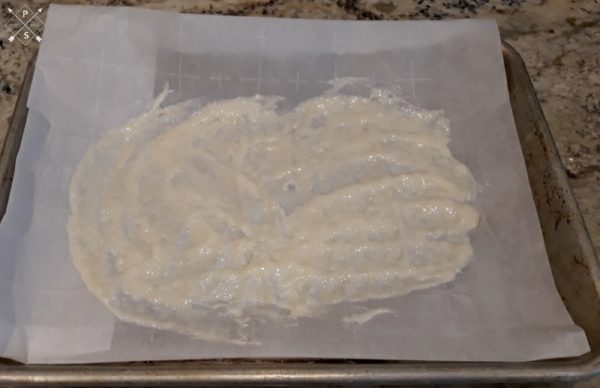
Let it sit out for a couple of days and dry. The thinner you spread it, the sooner it will dry. Once it’s dry, separate it from the waxed paper.
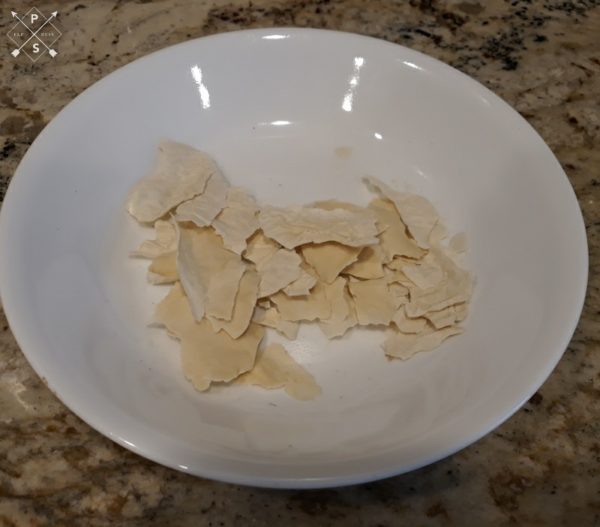
I then vacuum seal it and place it in the freezer.
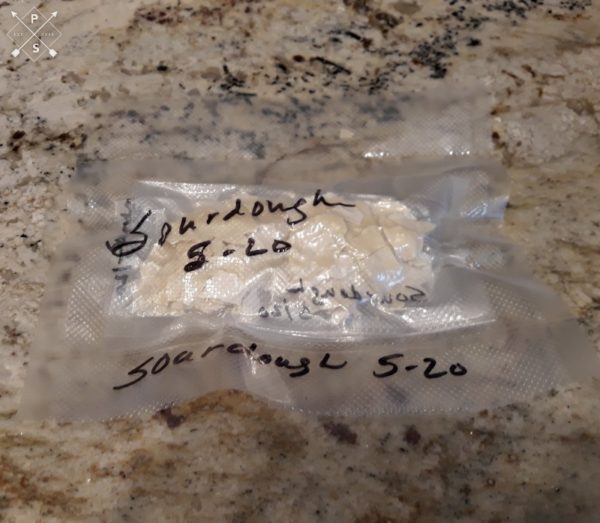
Because the bags are small, I place several of them in a bit larger bag and vacuum seal them together and keep them on the shelf in the door of the freezer.
If/When you need to use one of the dried starters, I mix it with water til it looks the consistency of starter (it doesn’t have to be perfect), then weigh the starter and go back to adding equal parts water/flour. If I have 10 grams of dried starter rehydrated, I’ll add 10 grams of flour and 10 grams of water. Then, when it’s time to feed it again, I may have 30 grams of starter (I should!), I’ll add 30 grams each of water and flour. I should be back in business by then.
Flour:
At this point . . take what you can get but my favorites are these . . in this order: Wheat Montana, Honeyville’s Imperial High Gluten Flour and third is King Arthur’s All Purpose Flour. All of these are hard to find at the moment.
Elaine talks a lot about flour (see link above). She states that flour should be between 12.5% and 14% protein but that number is not always easy to find.
Wheat Montana All Purpose:
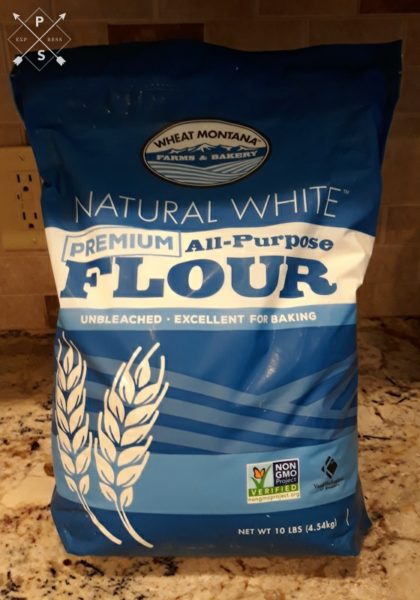
I fell in love with this flour when we lived in Missouri. I was able to buy it in 50 pound bags from an Amish store. Walmart carries it in some stores (not ours) but under normal conditions (and sometimes now) you can get it online. The protein content, according to Wheat Montana, is 12.25% (+/- .5%). This is the flour I use 99.9% of the time. The only time I don’t use it is when I can’t get it. At the current time, when Walmart does have it online, there’s a limit of two – 10 pound bags. I will find something else I need in order to reach the $35 minimum order and get free shipping. Now, the price of the flour is $5.98/10 pound bag so, with free shipping, that’s about .60/pound.
Honeyville Imperial All Purpose:

Another one that’s impossible to find now. Having to buy a 50 pound bag may not be something everyone wants to do.
According to Honeyville, the protein content in this one is 13.1 – 13.8% so it is more in line with what Elaine recommends. I do keep this and I use it as a backup to Wheat Montana and honestly I don’t see any difference in the finished bread based on either flour. The cost of this comes out to $1.25 per pound. The current cost is $52.99 for the flour plus $8.99 per shipping. I actually don’t know if it’s $8.99 per bag or per order. Either way, for 50 pounds, the shipping isn’t bad but it does make this flour cost over twice as much as Wheat Montana and being able to buy the Wheat Montana in 10 pound bags makes it much more attractive to me.
King Arthur All Purpose:
I don’t have any of this flour but it’s in a red bag. King Arthur is out of this also. Normally, you can buy it in a 10 pound bag from them for $9.95 so basically, it’s $1.00 per pound at King Arthur if you reach the free shipping threshold. Walmart often has it online for less . . but it’s out of stock as of this writing.
The protein content of this flour is 11.7% and King Arthur does have that number posted on the front of their bags, which is very nice!
Flour Summary:
You can see that for the price and the protein percentage isn’t bad, I’ll stick with Wheat Montana unless I come across something I like better. This has been my favorite flour for probably 12 years so I don’t know that I’ll ever find anything I like better.
Water:
Not all water is created equally. I’m only passing along what I’ve read and this is not from experience. I use well water that is not filtered. Our water works great for bread (and is amazing for drinking). If you have water with chlorine added, I’ve read that you can fill a bowl with water and let it sit out overnight and the chlorine will dissipate/evaporate. I asked Vince, who my resident expert on all things and he said “the free chlorine will come out but the chloramine probably does not”. Having never heard of chloramine, I googled it and found this on this site: “When watering with chlorinated water the majority of the chlorine will evaporate after 8 or so hours, but chloramine takes days to evaporate. . ”
Then I googled whether chloramine will affect yeast or sourdough and came across this discussion at The Fresh Loaf. I probably would not start off using tap water if your water is chlorinated.
Water Summary:
Because using tap water is the easiest way to proceed, my recommendation is this:
- Buy Spring Water in a bottle (not distilled!); make sure it is from a spring and no chlorine is in it. Get your starter going. Once it’s alive and well, divide and try feeding a little using tap water. See what happens. If it seems fine, I’d continue using tap water (or whatever water you drink and use for cooking.
- If the experiment with the tap water produces less than acceptable results, you’re going to have to stick with buying water.
Salt:
There’s also always a lot of discussion about salt. Iodized? Sea salt? Canning Salt? Kosher Salt?
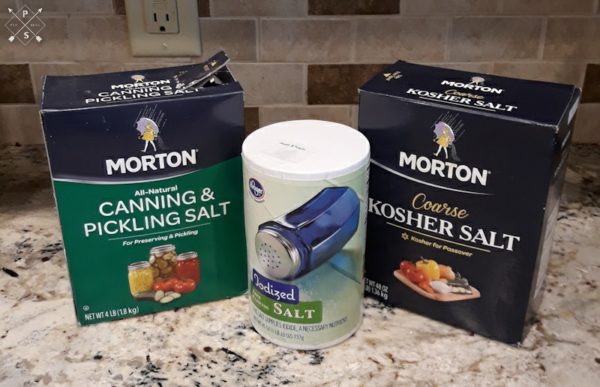
My preference is the canning/pickling salt. It does not have iodine – just salt. But, I’ve used iodized salt and not had any problems. The Kosher salt I have is coarse salt and that’s what we use for salmon. I wouldn’t use the coarse variety but Kosher salt should be fine to use too.
Then there’s the question about when to add the salt. Some say it inhibits the yeast activity and will add it towards the end of the process. I actually have better luck adding it in the beginning but please experiment and see what works best for you.
One thing I’ve learned, there are so many factors that can change the bread baking result. Experiment! Don’t be afraid. I used to say “It’s just flour!” but these days, I feel really anxious about my flour supply.
Later this evening or tomorrow, I’ll do a post about the mixing/baking process.

Cilla says
In the past you have mentioned the whole grain MoHo grinder and the grains like soft wheat, hard wheat, hard red wheat. Do you not use them for bread making? I’ve been looking forward to my delivery of the above.
Judy Laquidara says
I don’t use it a lot for sourdough. That wheat makes it heavy. I’ll often use either 50 grams of spelt or buckwheat or 100 grams of hard red wheat. When I’m using yeast, I mostly use all fresh ground whole grains. The new book by Sourdough by Foodbod will e all about sourdough with whole grains and I’m anxious to see that.
Liz says
I always put my yeast in the freezer and have about 5+ jars. I started a batch of artisan bread yesterday and let the yeast warm up on the counter, added the salt and sugar and then added the warm water. After an hour, it was bubbling away. When I open the next jar, I’ll test it to see if it is still good. When I was at the grocery store before the shutdown, I picked up a jar and that’s my freshest one (2021). Al the rest are from 2013-2018. I wanted to be able to make bread and didn’t want to be stuck with multiple jars of dead yeast. We’ll soon see.
There is a post on The Pioneer Woman on making sourdough naan – so my experiment today will be to try to make some using the current dough. My bread recipe is a bit different, but I’ll try making one.
Judy Laquidara says
Good! It’s not fun to have to worry about running out of anything! Let me know what you think of the naan. I’m going to make sourdough banana bread tomorrow.
Liz says
It’s working out ok, though I am still testing the process.
My first batch, I let the dough warm up since it was in the refrig. Wrong, the dough was too sticky to work, even with a bit more flour. So, today I added more flour and pressed out the dough while cold. When I cooked it, it was more like fry bread that you get at fairs. It was still good, though not like the naan you expect. Of course, I pressed the dough out vs using a rolling pin.
I checked the Artisan Bread in Five Minutes book and they described the naan process. The dough I made (with a 1/4 cup of olive oil) was not one of the recommended dough recipes. So, tomorrow, I’ll add more flour so that using the rolling pin is easier. And, I’ll try another dough recipe the next time.
Conclusion – it is an option for a quick piece of bread since you are not resting the cold dough to then bake.
Judy Laquidara says
I saw that the Sourdough by Foodbod site also has a Naan recipe. Maybe I’ll try that.
Regina says
Great post. I try not to eat much bread because I love it and butter too much. Quarantine has caused my jeans to shrink already!
Judy Laquidara says
That seems to be happening to our jeans also!
Susan Nixon says
If chlorine is the problem with tap water, just let it sit out for 30 minutes or so and the chlorine evaporates. I’ve not had problems with tap water here, but I buy bottled water anyway, because I like the test better. Unless I’m in Arizona. I like the taste of west Phoenix water. =)
Judy Laquidara says
It all depends on how much chlorine is in the water. The chloramine does NOT evaporate out for days and it can cause a problem. It doesn’t always but it can. The chloramine is the part of chlorine that binds with organics in the water. There are lots of factors that can come into play. They don’t always but they can so IF leaving the water sitting out overnight doesn’t cure any problems, it’s probably chloramine and that’s when spring water would be needed.
Judy H says
Now and then I dry some starter. I spread the bubbly active starter on a piece of parchment paper and put it in my dehydrator on the lowest setting. It’s really just like air blowing around, without any noticeable heat. Then I break it up and grind it before freezing it. I think it’s easier to get going again if it’s ground up. It does make me feel secure to see starter in the freezer!!
Lee Young says
Way back in the past I’d made starter from scratch and never had a problem; lately, I seem to not be able to get mine going sufficiently. One got fuzzy mold on it – figured using just cheesecloth and jar ring to cover caused it to get a dry crust on top which then molded-probably also forgot a feeding…or two, lol. The other got an odor that smelled like old paint – so both went out, and I’ll try again soon. Before either turned bad, I had frozen some of the discard. Frankly, I’m surprised there are enough folks out there who would be baking their own bread, whether sourdough or not, to deplete the flour supply, but then I think of the other items that flew off the shelves. Panic does strange things to people. I just think to myself ‘This too shall pass.’ (hopefully) My favorite sourdough from the store is by San Luis and is their cracked wheat variety. The last time I went to the store (about 2 wks ago), there was plenty of bread, but no flour except in 25-lb or larger bags – having just tossed my starter, I wasn’t buying that much flour and bought the ready-made bread. Oh, and I didn’t have any yeast, but my daughter ordered some as a gift for me, and it is now here.
Judy Laquidara says
I think there are a whole lot of people making sourdough now. There’s a lot of talk about it on the internet.
Christine says
You mentioned using rice flour – I have to avoid gluten (it’s a migraine trigger) so that intrigued me. Do you use it in your sourdough?
Judy Laquidara says
No, not in the dough. The rice flour is just to dust the banneton.
Tu-Na Quilts says
My favorite flour is Dakota Maid that is milled in North Dakota (The North Dakota Mill and Elevator Association is the only state-owned milling facility in the United States). Check out their website https://www.ndmill.com. They make all purpose, white whole wheat, whole wheat, Bread Flours and bread machine mixes and pancake mixes which are available in 5-100 pound bags (size varies by variety). It’s the only kind of flour I buy!!
Judy Laquidara says
I checked it out and was going to order some but the shipping on a $25 order was $58 so I don’t think I’ll be ordering. I’m not complaining . . shipping is expensive but that makes the flour a bit expensive. Maybe some day I’ll come across some of it and I’ll definitely try it. Thanks for mentioning it.